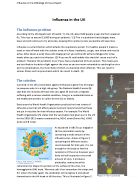The pharynx or throat is a short passage that joins the nasal cavity to the larynx. The walls of the pharynx are composed of skeletal muscle and again are lined with a mucus membrane. Persistent smokers can scorch the delicate tissues that line the back of the pharynx causing painful blisters. Cells lining this area are damaged and eventually die.
Next in the passageway is the larynx or the voice box. Air passes through the pharynx and the larynx on the way to the trachea (windpipe) while travelling into the lungs. The larynx has a small piece of tissue over it, called the epiglottis, to keep food from going into the air passages. Hoarseness may develop from cigarette smoke blowing down over the larynx, making the smoker prone to laryngitis and cancer of the larynx. Laryngitis is an inflammation of the vocal cords, which then interferes with the vibration of the folds. Cancer of the larynx is a disease in which cancerous cells are found in the tissues of the larynx. This cancer is also called laryngeal cancer and is most commonly found in people who smoke. It can develop in any region of the larynx, the glottis (where the vocal cords are), the supraglottis (the area above the cords), or the sub glottis (the area that connects the larynx to the trachea).
The trachea splits into right and left main stem bronchi one entering each lung. The tubes are lined with pseudostratified ciliated epithelium. The cilia have the same job as in the nasal area but instead of forcing the mucus downwards through the pharynx, it forces it up towards the larynx. From there it can go down to the stomach.
Cigarette smoking is the overwhelmingly most important cause of Chronic Obstructive Pulmonary Disease. It causes two major kinds of damage to the lungs. The air sac damage we call emphysema and the airway damage we call chronic bronchitis. These two diseases usually arise together, but can occur on their own. Chronic bronchitis is the inflammation of the bronchial tubes. When irritants such as cigarette smoke have irritated the airways, the goblet cells respond by producing more mucus. Gradual paralysis of the cilia, allows build up of mucus to accumulate in the terminal bronchioles. The air can no longer rush out of these airways fast enough to create a powerful cough, allowing bacteria to breed.
The alveoli are the functional units of the lungs. They are found at the very tips of the terminal bronchiole. A diagram showing the location of the alveolar can be found in figure 1. They look like grape clusters. Figure 2 shows a closer view of the alveoli. This is where the oxygen in the air you breathe is filtered into your blood stream. Tar from cigarettes, damages the alveoli and cause thickening and loss of elasticity in the air sac. The lung loses its elasticity (similar to an overused rubber band), and therefore these areas of the lungs become enlarged. These enlarged areas trap stale air and do not effectively exchange it with fresh air.
Lung cancer is most likely to develop in the lungs of a smoker. There are two types of primary lung cancer. Non-small cell lung cancer and small cell lung cancer. Non-small cell cancer is more common than small cell lung cancer and it usually grows and spreads more slowly. There are three main types of non-small cell lung cancer. Squamous cell carcinoma is the most common and develops from the cells that line the airways. It usually starts in the large bronchi and very often stays in the chest, without spreading, for longer periods of time than other lung cancers. Adenocarcinoma also develops from the cells that line the airways but develop from a type of cell that produces mucus. These tumours are often found along the outer edges of the lungs and under the lining of the bronchi. Large cell carcinoma got its name because the cells look large and rounded. It is a term used for lung cancers that do not fit into other categories of epidermoid, adenocarcinoma or small cell. Large cell carcinoma is most often found in the smaller bronchi.
Small cell lung cancer is also called Oat Cell lung cancer because the cancer cells are a distinctive oat shape. Cancer is a disease where cells grow out of control and begin to attack and destroy normal tissue. The reasons behind the development of cancer are damaged genes. The gene damage is often caused by environmental factors like smoking. Squamous cell cancer is the most common type of lung cancer.
Researchers continue to study the causes of respiratory diseases and to search for ways to prevent them. It is clear from the information given that the best way to prevent any respiratory disorders or lung diseases is to quit (or never start) smoking. The earlier a person stops smoking the better. It is never too late to benefit from quitting. Not every case of lung cancer is caused by smoking, but people who do not smoke and are not exposed to second hand smoke are unlikely to develop cancer.







